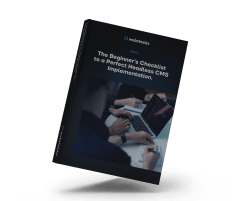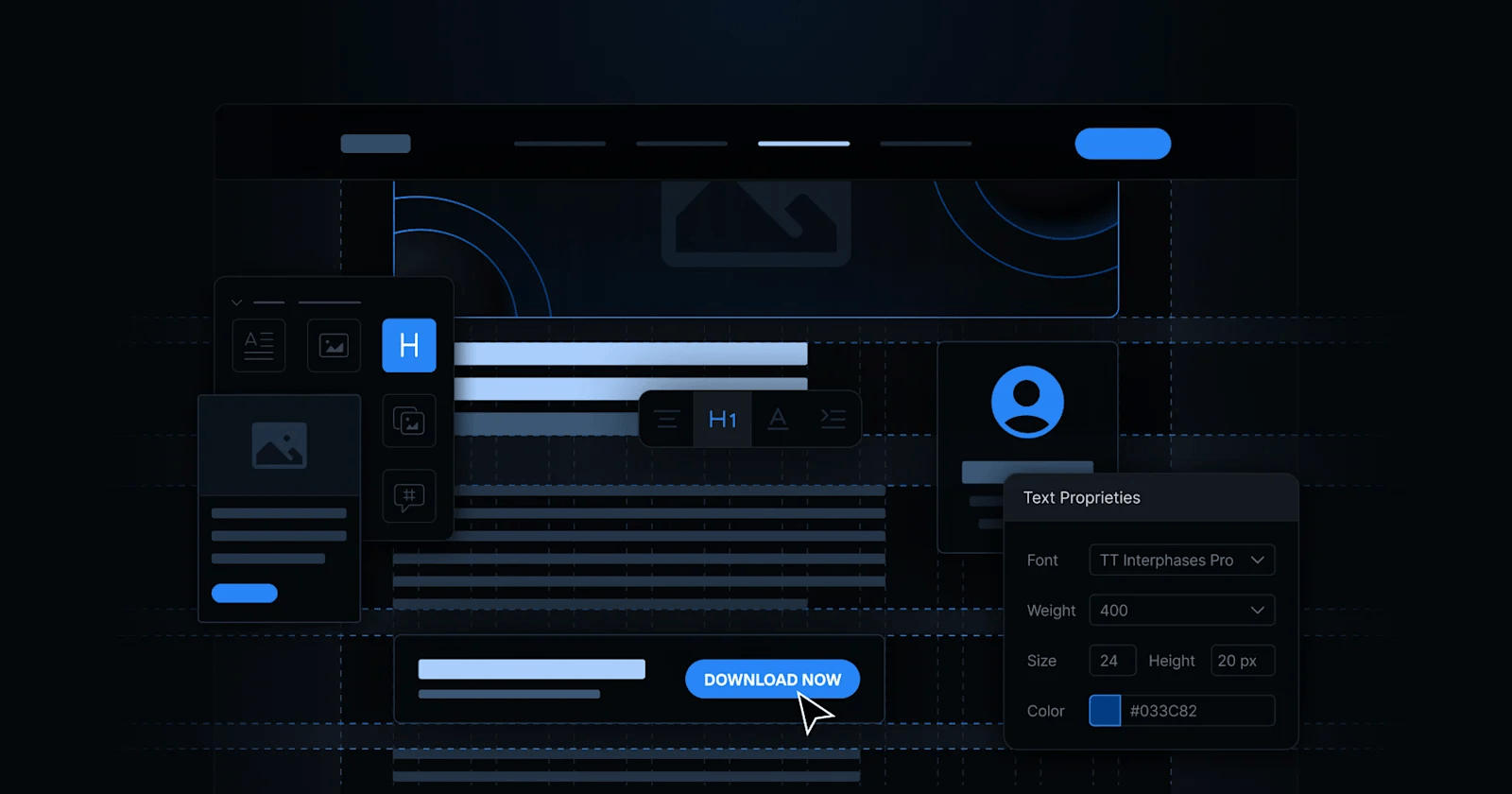In B2B marketing, your blog strategy can significantly impact your lead generation efforts. But what exactly constitutes a great B2B blog strategy? How can you ensure your content not only resonates with your target audience but also drives tangible results?
This article will cover how to develop a strategic, data-driven approach that puts your buyer personas first, ensuring your blog content effectively engages your audience and supports your larger business objectives.
Key Takeaways
- Understand your target audience's pain points and preferences to create content that engages them.
- Identify high-performing lead generation assets and opportunities to maximize your blog's conversion potential.
- Use keyword research to optimize your content for visibility and discoverability on search engines.
- Streamline your content production process to ensure a consistent cadence of valuable, SEO-driven blog posts.

What is a B2B Blog Strategy?
A well-crafted blog strategy is a vital component for businesses seeking to connect with their target audience. Contemporary B2B has been transformed by the rise of social media, AI, personalization, and the growing expectation for authentic, valuable content from the brands we engage with.
Today, 73% of B2B leads are not ready to make a purchase when they interact for the first time with your brand. B2B decision-makers are actively seeking out educational content that informs them about the products and services they are considering.
This shift in buyer behavior has presented B2B marketers with a unique challenge: to create a blog content strategy that captures the attention and trust of their target audience.
A deep understanding of your audience's needs, pain points, and the type of content they find most valuable is important. By aligning your blog content with the specific challenges and interests of your target market, you can position your brand as a trusted authority and a valuable resource in your industry.
At Webstacks, we understand that a deep understanding of your audience's needs, pain points, and the type of content they find most valuable is paramount. By aligning your blog content with the specific challenges and interests of your target market, you can position your brand as a trusted authority and a valuable resource in your industry.
The best B2B websites are crafting a B2B blog strategy that takes a multifaceted approach, including audience research, lead generation tactics, keyword optimization, and a scalable content production process.
9 Steps for Turning Your B2B's Blog into a Lead Gen Machine
Building a successful B2B blog strategy is crucial for driving lead generation and business growth.
These nine steps can turn your B2B blog into a successful lead-generating tool.
- Understand Your Audience: Conduct thorough research to identify your target B2B customers, their pain points, and their content preferences. This will help you create content that resonates and addresses their specific needs.
- Identify Lead Gen Magnets: Take inventory of your most effective lead generation assets, such as whitepapers, webinars, or product demo sign-ups. Leverage these high-performing elements to drive conversions from your blog content.
- Conduct Keyword Research: Use tools like Ahrefs or Semrush to identify the keywords and search queries your target audience is searching for. Integrate these keywords into your blog content and lead generation strategy.
- Outline Blog Content: Develop detailed content outlines that align with your target keywords and lead generation objectives. This will ensure your blog posts are focused, informative, and optimized for conversions.
- Implement Content Writing: Establish a consistent content production plan, using a team of skilled writers to create high-quality, engaging blog posts that educate and inspire your B2B audience.
- Build a Scalable Blogging Process: Streamline your blog management and publication workflow to ensure a steady stream of fresh, relevant content that keeps your B2B audience engaged and coming back for more.
- Optimize for SEO and User Experience:
- Leverage Social Media for Promotion:
- Measure and Optimize: Continuously track the performance of your B2B blog content and lead generation efforts. Use data-driven insights to refine your strategy and maximize the impact of your B2B blog.
By following these nine steps, you can transform your B2B blog into a powerful lead generation machine, driving valuable conversions and propelling your business forward.
Let’s take a look at each step in more detail.
#1: Understand Your Audience
A B2B blog strategy starts with understanding your target audience. Throwing your B2B marketing content into the dark and hoping the right people find it won't work.
Analyzing Audience Needs and Problems
Think about what type of B2B businesses currently use your product or service and why. Speak to account holders and previous clients about the specific pain points you solve and the unique value you bring.
Then gather data points on your customers, such as company size, location, industry, as well as demographic details about key stakeholders like age, job title, and previous buying habits.
This will allow you to tailor your tone of voice and B2B content marketing to appeal to each stakeholder directly.
Conducting Interviews for Insights
Go beyond surface-level analytics and speak directly to your target audience. Conduct informative interviews to uncover the deeper needs and problems they face.
Ask probing questions to understand their daily challenges, their current content consumption habits, and what types of blog content would be most valuable.
- Define Your Audience Segments: Identify your ideal customers based on industry, role, company size, and the problems they need to solve.
- Map the Customer Journey: Outline the stages your audience goes through—from awareness to decision—and tailor content to each phase.
- Identify Pain Points: Research the challenges your audience faces. Talk to your sales and customer service teams to learn the common questions and issues that arise.
This qualitative data will inform your B2B blogging strategy and ensure you create a blog that resonates with the right B2B marketers, addressing their specific needs and interests.
#2: Identify Lead Gen Magnets
Identifying effective lead gen magnets is a crucial step in your B2B blog strategy.
Take Inventory of Your Most Effective Lead Generators
Start by evaluating your existing lead generation magnets— which have been the most successful and are still effective today? If any have been performing well and fit into your content strategy, continue to use them.
Consider using the following lead gen magnets to engage and convert customers:
- Ebooks
- Whitepapers
- Industry reports
- Guides
- Templates
- Calculators
A critical piece of the strategy is aligning your content with a relevant, enticing offer. Your blog should utilize key website features such as conversion panels, slide-ins, and other design elements to seamlessly promote these lead gen magnets.
Ideate New Lead Gen Opportunities
Brainstorm new types of lead gen magnets that align with the pain points and informational needs of your B2B audience. This could include:
- In-depth industry reports
- Product demos
- Free trials
- Interactive tools
Explore opportunities to repurpose existing content into new lead gen formats, such as turning a popular blog post into a downloadable guide or converting a webinar recording into an on-demand resource.
By integrating these elements effectively, you can create a smooth user journey that encourages conversions and enhances the overall effectiveness of your B2B blog strategy.
#3: Conduct Keyword Research
As you work to create your B2B blog strategy, conducting thorough keyword research is a significant step.
By identifying the right keywords and phrases your target B2B audience is searching for, you can craft blog content that resonates and helps drive lead generation for your B2B company.
Using Tools like Ahrefs or Semrush
Leading SEO tools like Ahrefs or Semrush can be invaluable in uncovering the most relevant keywords for your B2B blog strategy.
These platforms provide detailed data on search volume, competition, and content opportunities to help you make informed decisions about your B2B content marketing approach.
Dedicate a considerable amount of time to uncovering the queries and make lists of keywords, weighing their difficulty and search volume against their intent and relevance to your business.
Integrating Keywords into Lead Generation Strategy
Once you've identified the best keywords to target, it's time to weave them into your lead generation strategy.
Optimize your blog posts and other content assets to rank well for these keywords, and use them to create valuable, gated content like whitepapers or webinars that can capture leads.
By integrating your keyword research with your overall B2B content strategy, you can transform your blog into a powerful lead generation tool.
#4: Outline Blog Content
Crafting an effective B2B blog strategy requires thoughtful planning when it comes to your blog content. One key step is turning your keyword research into impactful blog content outlines.
Turning Keywords into Outlines
Group related keywords together and use these keyword clusters as the foundation for your blog content outlines. For each outline, consider the following:
- Identify Content Types: Determine what type of content would best address your audience's needs, such as an in-depth guide, a listicle, or a how-to tutorial.
- SEO Optimization: Ensure that your headings are SEO optimized and that you integrate CTAs where relevant.
- Context for Writers: Provide important context for writers regarding what to include in each section to ensure the content is thorough and relevant.
- Internal Linking and CTAs: Call out where it makes sense to internally link and include conversion CTAs to drive engagement and lead generation.
By aligning your blog content closely with your audience's search intent and pain points, you'll be well on your way to crafting a strong B2B blog that drives measurable results for your B2B content marketing efforts.
#5: Content Writing
71% of B2B buyers consume blog content during their buyer journey. Writing compelling B2B blog content is crucial for capturing the attention of your target audience and driving lead generation.
Formulate a Content Production Plan
An effective content production plan involves several key elements:
- Editorial Calendar: Develop a comprehensive editorial calendar that maps out your B2B blog content for the year. This allows you to strategically plan topics, keywords, and lead gen opportunities.
- Content Ideation: Regularly brainstorm new blog content ideas by analyzing your target audience's pain points, industry trends, and competitor activity.
- Content Creation: Establish an effective process for blog content creation, including research, writing, editing, and optimization.
- Content Promotion: Leverage various channels, such as social media and email, to amplify your B2B blog posts and drive traffic.
- Content Repurposing: Maximize the value of your content by repurposing it into different formats, such as videos, infographics, or social media posts.
By implementing a well-structured content production plan, you can ensure a steady flow of high-quality, B2B blog content that supports your overall B2B marketing and content strategy.
#6: Build a Scalable Blogging Process
To truly drive results, you need to establish a scalable blogging process that streamlines content creation, distribution, and measurement.
Develop a Content Plan
Map out your content strategy and KPIs by identifying topics, formats, and publishing cadence that align with the needs of your target audience, your keyword research, and your B2B marketing objectives.
Streamline Content Creation
Establish an efficient workflow for content ideation, writing, editing, and publishing. Leverage tools and templates to ensure consistency and scalability.
Optimize Content Distribution
Utilize a mix of content marketing channels, such as email, social media, and search engine optimization (SEO), to reach your B2B audience effectively.
#7: Optimize for SEO and User Experience
To transform your B2B blog into a lead generation engine, it's essential to optimize it for search engines and provide a great user experience.
SEO in B2B Content Strategy
Search engine optimization boosts your blog's visibility to potential clients. Begin by conducting keyword research to find the terms your audience uses when searching for solutions. Focus on long-tail keywords to target specific queries and reduce competition.
Incorporate the keyword naturally throughout the post, including in the:
- Title: Craft a clear and concise title under 70 characters.
- URL: Use a simple structure that includes the keyword.
- Meta Description: Write a compelling summary that encourages clicks.
- Headers and Body: Include the keyword in headings and content where relevant.
- Image Alt Text: Describe images using the keyword to improve accessibility and SEO.
Utilize internal and external links with descriptive anchor text to enhance SEO and provide additional value to readers. Regularly publishing valuable content helps you engage potential customers at every stage of the buyer's journey.
Enhancing User Experience
A positive user experience keeps readers engaged and encourages them to explore more of your content. Design your blog with readability and navigation in mind:
- Clear Formatting: Use short paragraphs, bullet points, and subheadings to make content easy to scan.
- Visual Elements: Incorporate images, videos, and infographics to illustrate points and break up text.
- Responsive Design: Ensure your blog is mobile-friendly and accessible on all devices.
- Fast Loading Times: Optimize images and use efficient code to improve page speed.
At Webstacks, we specialize in creating web designs that enhance user experience, ensuring that visitors to your blog stay engaged and find the information they need quickly.
#8: Leverage Social Media for Promotion
To expand your blog's reach, connecting it with social media is crucial. Sharing your posts across platforms helps attract more readers and potential leads.
Integrate Social Media with Your Blog
Add social sharing buttons to your blog posts to make it easy for readers to share your content. Engage with your audience by responding to comments on social media and your blog. This interaction can foster relationships and provide insights into topics your audience cares about. Use feedback from these interactions to generate new blog ideas that address their needs.
Effective Social Media Platforms for B2B
Focus on the platforms most relevant to your audience. LinkedIn is particularly effective for B2B marketing, allowing you to connect with professionals and share industry insights. Sharing your blog posts on LinkedIn can increase visibility among decision-makers. Twitter can also be useful for sharing updates and engaging in conversations. By promoting your content on these platforms, you can reach a wider audience and drive more traffic to your blog.
#9: Measure and Analyze Performance
To ensure your B2B blog is achieving its goals, it's important to regularly measure its performance and make data-driven adjustments.
Key Metrics for Blog Success
Monitoring the right metrics helps you understand how your content resonates with your audience. Key metrics to track include:
- Website Traffic: Observe the number of visitors to your blog to gauge overall interest.
- Engagement Rates: Look at metrics like time on page and bounce rate to assess how engaging your content is.
- Conversion Rates: Track how many visitors take desired actions, such as signing up for newsletters or downloading resources.
- Lead Generation: Measure the number and quality of leads generated through your blog content.
- Top-Performing Content: Identify which posts attract the most attention to inform future topics.
Using Analytics Tools for Performance Tracking
Analytics tools provide valuable insights into your blog's performance. Platforms like Google Analytics help you monitor traffic, user behavior, and conversion rates. Additionally, behavioral analytics tools like MouseFlow and Hotjar allow you to see how readers interact with your content, offering deeper insights into user experience.
Regularly reviewing these metrics enables you to refine your content strategy based on what works best for your audience. By focusing on data, you can optimize your blog to better meet your goals and drive business growth.
Enhancing Your B2B Blog Strategy
Crafting an effective B2B blog strategy is crucial for attracting, engaging, and converting your target audience.
By focusing on understanding your target audience, identifying lucrative lead gen magnets, conducting thorough keyword research, outlining engaging blog content, and establishing a scalable blogging process, you can create a B2B blog strategy that sets your B2B company up for success.





